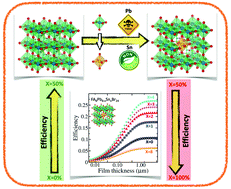Understanding the role of Sn substitution and Pb-□ in enhancing the optical properties and solar cell efficiency of CH(NH2)2Pb1−x−ySnx□yBr3†
Abstract
Formamidinium lead bromide (FAPbBr3) perovskite has drawn scientific interest in the field of optoelectronic devices. However, the presence of highly toxic lead restricts its application. We approach this problem by studying the role of Sn substitution and Pb vacancy (Pb-□) in reducing the lead concentration and enhancing the stability and solar cell efficiency by forming a composite CH(NH2)2Pb1−x−ySnx□yBr3 (FAPb1−x−ySnx□yBr3) perovskite. Using the state-of-the-art hybrid density functional theory, we have discussed the important role of spin orbit coupling (SOC) and an electron's self-interaction error. The co-existence of Sn substitution and Pb-□ have been found to be thermodynamically stable using ab initio atomistic thermodynamics. However, Pb-□ introduces trap states deep inside the forbidden gap, which leads to electron–hole recombination centers to reduce the solar cell efficiency. Therefore, the stable configurations with only Sn substitution (FAPb1−xSnxBr3) are considered for further optical study. As compared to the pristine, the mixed perovskites FAPb1−xSnxBr3 with 0 ≤ x ≤ 0.5 are inferred to be promising candidates for solar cell applications because of their better optical properties, higher absorption coefficient and larger spectroscopic limited maximum efficiency (SLME) values.



 Please wait while we load your content...
Please wait while we load your content...